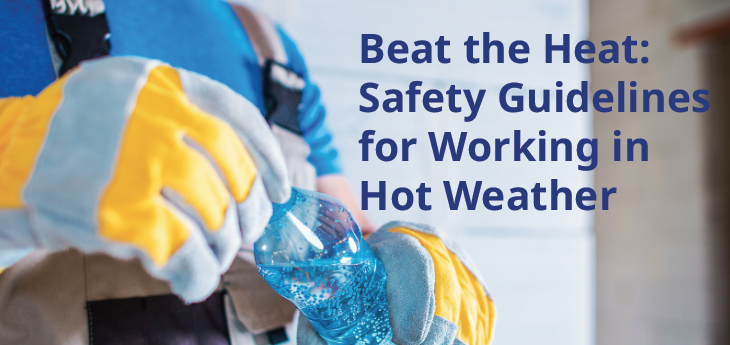
As the summer months approach, it’s essential for workplaces in Iowa to prioritize the safety and well-being of their employees amidst rising temperatures and humidity levels. Heat-related illnesses can pose significant risks to workers, particularly those engaged in outdoor labor or working in environments with limited air movement. To ensure a safe and healthy workplace during the summer months, here are essential guidelines for heat safety and hydration:
1. Plan Your Work for Hot Weather
Employers should proactively plan and prepare for working in hot weather conditions. According to the Occupational Health and Safety Administration (OSHA), heat-related illnesses can affect workers across various industries, whether indoors or outdoors. Some job-related risk factors include outdoor work in warm weather, heat sources such as ovens or fires, strenuous physical activity, and heavy or non-breathable work clothes. Employers should create a written plan to prevent heat-related illnesses, including provisions for oversight, gradual heat tolerance development for new workers, adequate first aid, engineering controls, and worker training. Day-to-day supervision is crucial, with appointed individuals responsible for monitoring conditions and implementing heat stress controls throughout the workday.
2. Provide Access to Water
Employers must ensure that ample drinking water is readily available to all employees throughout the workday. Encourage regular hydration breaks, even if workers don’t feel thirsty. Consider installing water stations or providing personal water bottles. Additionally, alternative hydration sources such as sports drinks and popsicles can be beneficial.
3. Implement Work/Rest Schedules
Establish work/rest schedules that allow employees to take regular breaks in shaded or air-conditioned areas. Schedule strenuous tasks for cooler times of the day and provide additional breaks during periods of extreme heat. Encourage employees to listen to their bodies and report any signs of heat-related discomfort immediately.
4. Provide Personal Protective Equipment (PPE)
If employees are required to wear PPE, ensure that it is lightweight, breathable, and suitable for hot weather conditions. Consider providing cooling vests or other heat-reducing PPE options to mitigate the risk of heat-related illnesses.
5. Educate Employees on Heat Safety
Train employees on the signs and symptoms of heat-related illnesses and emphasize the importance of early action. Encourage workers to watch out for each other and report any concerns promptly. Provide information on accessing medical assistance in emergencies.
6. Modify Work Practices
Modify work practices to minimize heat exposure and reduce the risk of overheating. Consider implementing rotating work assignments or providing additional breaks during extreme heat. Utilize engineering controls such as shade structures or fans to create a cooler work environment.
7. Monitor Environmental Conditions
Keep an eye on weather forecasts and monitor environmental conditions throughout the workday. Implement heat stress monitoring programs to assess the risk of heat-related illnesses and adjust work practices accordingly. Heat stress monitoring devices or apps can aid in real-time tracking of heat exposure.
8. Encourage Heat-Related Illness Reporting
Encourage employees to report any symptoms of heat-related illnesses promptly and establish procedures for addressing such reports. Ensure access to first aid resources and designate personnel trained to respond to heat-related emergencies effectively.
By prioritizing heat safety and hydration in the workplace, employers can protect their employees from the dangers of extreme heat and create a safer, healthier work environment for all. By implementing these guidelines and fostering a culture of heat safety awareness, workplaces in Iowa can mitigate the risks associated with summer heat and ensure the well-being of their employees.
Renewal Documents Available
You can access your electronic annual renewal documents by logging in to the portal on IMWCA’s website. The premium invoices will still arrive via postal mail. Please contact us at imwcamemberaccess@iowaleague.org if you need help with your username and password.

As we near the end of May, many schools are winding down and Memorial Day signals the unofficial start of summer. For many of us, that means it’s time to tackle the swimming pool and get it ready for use.
If you have a municipal pool, it’s important to have a Certified Pool Operator who is responsible for managing the chemical operations of the pool. The chemicals should be stored in a dry area, away from patrons, and kept separately from each other. Each chemical should be in its own dedicated location, and incompatible chemicals should be kept apart. Storage should be away from direct sunlight, and the chemicals should be kept in their original containers, which bear the manufacturer’s labels. Each chemical should also have a Safety Data Sheet (SDS), which can usually be found on the manufacturer’s website. The SDS should be stored in or near the chemical storage area, and an off-site copy should be kept in case of an emergency.
It’s essential to ensure that only trained and certified individuals handle the chemicals and that they feel comfortable and confident in their knowledge to safely perform the operations. When handling the chemicals, do so in a well-ventilated area, use only one product at a time, and properly seal and store each chemical before opening another. Never mix chemicals, as a combination of chlorine and acid products can create toxic gases. If you need to add water to a chemical, always add the chemical to the water, not the other way around, to avoid the possibility of an explosive reaction.
In the event of a spill or reaction, follow the pre-planned Emergency Chemical Spill Plan, which should include contacting 911. When disposing of chemicals, refer to the label for safe disposal instructions, and never reuse containers. If you come across any leftovers without a label, contact your local Hazardous Materials agency for guidance on proper disposal.




